West End Baptist Meeting
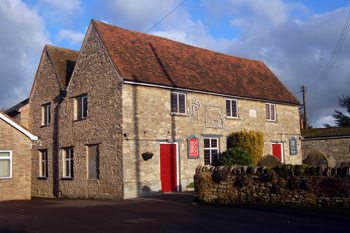
West End Baptist Meeting December 2009
The Stevington Baptish Church Book, beginning in 1673, notes that the meeting began about 1655. H. G. Tibbutt in his pamphlet on the history of the meeting notes that in 1665 the Five Mile Act was passed, forbidding Nonconformist ministers from conducting meetings within five miles of a town. Stevington is more than five miles from Bedford, "Not that the Stevington congregation itself did not suffer persecution from time to time. Meetings often had to be held at night, usually close to the boundary of Turvey parish. The women of the congregation tied a woollen apron to four sticks and held it over the head of Stephen Hawthorne as he preached in the damp night air. When they were disturbed by the parish officers of Stevington they got through the hedge into the parish of Turvey, to prevent their being taken into custody".
Volume 110 published by the Bedfordshire Historical Records Society in 1996 and edited by Edwin Welch contains registrations of Bedfordshire nonconformist meetings drawn from a number of sources. Those for Stevington are as follows:
- On 16th May 1672 the house of Widow Reade was registered by Congregationalists. This term seems to have been used interchangeably with Baptist and Anabaptist at this date. The Declaration of Indulgence, passed in this year first allowed the registration of nonconformist meeting houses".
- On 2nd October 1798 the 1720 meeting house was registered by the minister John Millard along with William Bowyer, Robert Bowyer, John Tyso (whose house was registered on the same day [ABN1/1]) and Samuel Rose [ABN1/1 and 2/98]. Millard was a Congregational minister trained at the academy at Newport Pagnell [Buckinghamshire]. William and Robert Bowyer were Baptists, as shown by the fact that they helped to register a house occupied by Sarah Bowyer in October 1807 along with the minister, Joseph Such, William Prall, Lawrence Cumberland, John Wheaton, Thomas Cox, Richard Barcock and Sarah Bowyer herself [ABN1/1 and 2/133].
- In 1813 a building belonging to Margaret Poole was registered by Baptist minister Joseph Such, Margaret herself and William Pratt [ABN1/1 and 2/158].
- In October 1822 the house of another Bowyer, Thomas, was registered by Robert Bowyer, matmaker, Baptist minister Joseph Such, William Bowyer, John Fobee and Thomas Bowyer himself [ ABN1/2, 2.196 and 3/3].
- In November 1824 the house of Jeremiah Sansome of Turvey occupied by Robert Tyso was registered [ABN1/2, 2/211 and 3/3]. Given that John Tyso had been a Baptist it sees a reasonable bet that this, too, was a Baptist meeting place. Tyso was assisted in registration by Dinah Such, presumably some relation of the Baptist minister Joseph Such.
- On 29th May 1840 the Baptist Meeting House at West End was again registered, this time for the purpose of conducting marriages.
![West End Baptist Chapel interior about 1969 [Z50/112/21]](/CommunityHistories/Stevington/StevingtonImages/West End Baptist Chapel interior about 1969 [Z50-1.jpg)
West End Baptist Chapel interior about 1969 [Z50/112/21]
The current [2009] Baptist Meeting in West End was listed by the former Department of Environment in July 1964 as Grade II, of special interest. The Department noted that the building has a plaque stating that it was built in 1720 and renovated 1891. The building is constructed of coursed limestone rubble with an old clay tile roof. It has two storeys. H. G. Tibbutt in his pamphlet on the meeting states: "The hearers and members of the church decided that a more substantial building was needed than the barn in which they had met for so long. As was usually the case at this time, everyone helped in the project. Mr. Odell gave the ground and each hearer and member engaged to bring either materials or money. Mr. Marks a Roman catholic living nearly opposite to the new meeting-house site, gave the hauling of all the stone and early in 1721 the work of building (begun in 1720) was completed".
Bedfordshire and Luton Archives and Records Service has the deeds to the chapel, deposited by the trustees in 1956. The site of the meeting was demised for 999 years by Sir Rowland Alston, "son and heir of Dame Temperance Woolstenholme", Lady of the Manor on 4th February 1721 to the trustees, who were: William Bowyer of Stevington, yeoman; Thomas Lawrence of Stevington, yeoman; John Rubithon of Stevington, yeoman; John Lovell of Pavenham, yeoman; Richard Lambert of Stevington, yeoman; John Spencer of Pavenham, grocer and Thomas Lovell of Radwell, wheelwright. The site was described as being in the West End of Stevington and containing half a rood, bounded east by the house and grounds of Robert Negus, south by the house and grounds of Charles Warner, west by the ground of John Odell and north by the ground of Thomas Lawrence. This would make the site completely landlocked, presumably the road running south of the chapel has been omitted from the deed [X239/3].
The deed has the names of later trustees added at the bottom. These are: Thomas Stteff in place of Richard Lambert, deceased; Richard Stoake in place of John Spence, deceased; Robert Bowyar in place of Thomas Lovell, deceased; James Paine in place of John Rubothan "forfeited his place"; Joseph Cleasen in place of William Boyeare; John Rubethen in place of John Lovell. On 30th October 1773 John Davison, John Pain, Israel Wheatior and George Raban were added. John Gamby replaced Thomas Steef on 28th April 1773.
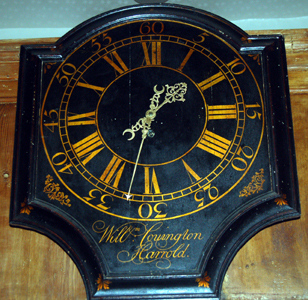
Clock by William Covington of Harrold in West End Baptist Meeting December 2009
About 1750 a clock was installed in the meeting. This clock is still there, now attached to the gallery. It is a Parliament Clock by William Covington of Harrold. Former County Archivist Chris Pickford published a volume on local clock and watch makers in 1991 (Bedfordshire Historical Records Society Volume 70). He discovered that Covington was son of Peter and Judith and was baptised in Turvey in April 1719. He married an Elizabeth Killingworth at Turvey in March 1744 and settled in Harrold in 1748. All the couple's four children were baptised in Harrold. Covington seems to have left the village around 1758, moving first to Hitchin [Hertfordshire], then to Stony Stratford [Buckinghamshire]. He is last mentioned in 1802 and was succeeded in the business by his son John.

Plaque to Joseph Such inside West End Baptist Meeting December 2009
In 1804 a new pastor, Joseph Such, was ordained. The meeting then had just 23 members. Such was minister for 26 years. In 1808 the house of a James Prasslow was registered for worship. It is not known for certain but it may have been done by Baptists unhappy with their pastor. In his reminiscences, written in 1822, Such declared: "I had many trials to encounter from the character of some in the church, but the Lord gave me courage to encounter and overcome every sinful combination". The previous year, 1807, the house of Sarah Bowyer was registered for worship by Such himself, amongst others. It is possible that this was a new site for the Sunday School.
In 1813, as seen above, a building belonging to Margaret Poole was registered for worship. This was probably because in that year Such established a Sunday School, which, presumably met in Margaret Poole's building. The registration came in handy, for other reasons, though, because the roof of the church was in poor condition by 1814 and urgent repairs cost £176. The church book notes: "While our meeting house was repairing we worshiped Six Sabbaths in a very commodious Barn, the property of Lord Spencer, commonly called the Rector's Tythe Barn, but in the occupation of Mrs. Margaret Poole of this Village, who with the greatest freedom imaginable gave us to worship therein, and we hope we can say that the Lord was pleased to make the place a Bethel to many of our souls, by honouring us with his presence on a threshing floor".
The houses registered for worship in 1822 and 1824 may have been venues for the Sunday School or may, once again, have been emergency measures because the meeting needed attention, though the church book does not mention it, if so. Another possibility is that they were for smaller meetings in parts of the village some way from the West End building. Joseph Such resigned his pastorship in 1830 and died on 12th November 1831, aged 86. His will is quite interesting in what he lays down for his funeral and burial (at the West End meeting). In his will he describes himself as citizen and currier of London [ABP/W1832/27]:
"It is my will and desire that no funerals sermon be preached for me by any person whatever nor any oration at my grave or elsewhere in commendation of me, that my coffin be strong and well put together without any plate, initials or inscription whatever and only two handles one at the head, the other at the feet for the convenience of those persons who may be employed in depositing my body in the grave, and that my coffin be neither coloured nor any decoration by nails or any ornament whatever and that I be carried to my grave by respectable members of the church I have, I hope, sincerely served and also that my body be deposited in the grave about the middle of the day … I leave to my dear children my blessing and to the dear people of my charge the same. I sincerely forgive all my misjudging friends …"

Plaque to Josiah and Phebe Such in West End Baptist Meeting December 2009
It is clear from memorial tablets inside the meeting that Joseph Such knew considerable sadness in his life. His son Josiah died in November 1807 aged just ten months, fifteen days. Similarly his daughter Phebe died in January 1818 aged nine years and two months. Finally, his twenty one year old son Stephen died at Buntingford [Hertfordshire] in May 1831 and was buried "in the Independent Meeting-yard".
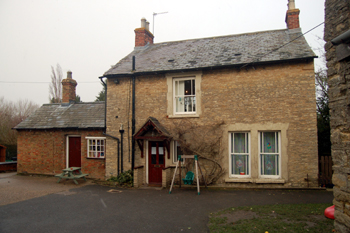
The Manse of West End Baptist Meeting December 2009
Until 1832 baptism of new members was made in the River Great Ouse. In 1832, however, a baptistery was built in the church yard. In the same year a manse was built for the pastor and his family, largely through the generosity of John Robinson, a Turvey lace maker, who donated £150 on the condition that £2 should be given to needy church members and that a letter he wrote to the church should be read annually. The following year a new vestry and a schoolroom were opened. The manse was listed by the former Department of Environment in June 1974 as Grade II, of special interest. It is built, like the meeting house, of coursed limestone rubble. It has ashlar dressings and a Welsh slate roof. It has two storeys.
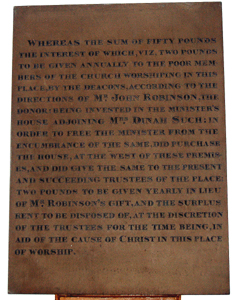
Robinson donation plaque inside West End Baptist Meeting December 2009
In 1840 a gallery was raised at the meeting . About this time village feasts were a problem to the elders of the meeting. Two women were barred for attending feasts in Harrold and Astwood [Buckinghamshire[ in 1833 and the church resolved: "any Member going to a feast or encouraging any relation to do so, to be exempted from the benefit of the Poor's Fund". In 1846 two women were excluded for "Dancing at the Feast time and Practising much Worldly Conformity"
The anniversary of 1855 was not celebrated until 1856 and then only in a low-key fashion, in contrast to the tercentenary a century later. In 1862 it was resolved to light the meeting by oil lamps. In 1871 William Saunders of Stevington gave three cottages and gardens in West End to the chapel trustees. The rents were to go towards the support of the minister [Z953/6/3]. The burial ground was closed by an Order in Council of 1882 [P71/2/3/1]. In 1891 the gallery was renewed and the floors re-boarded in the meeting. A new baptistery was installed at the end of the 19th century.
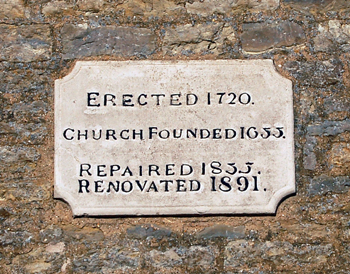
Plaque on the exterior of West End Baptist Meeting December 2009
By the early years of the 20th century attendances at services were 60 on Sunday morning, 80 in the afternoon and 90 in the evening. There were 53 Sunday Scholars and 12 teachers. These figures may be contrasted for those of 1851. On 30th March that year a census was carried out of public worship across the whole country. The Bedfordshire results were collated by David Bushby and published by Bedfordshire Historical Records Society as Volume 54 in 1975. Wilkinson Rowe reported that the meeting could hold 110 in free seats and 200 in reserved seating. That Sunday there had been general congregations of 100, 250 and 120 morning, afternoon and evening with 20 Sunday scholars in the morning and 23 in the afternoon. He had commented: "There is an open space were [sic] the Scholars sit were their [sic] are several free sittings so that when the Chapel is full it will hold little short of 400 people".
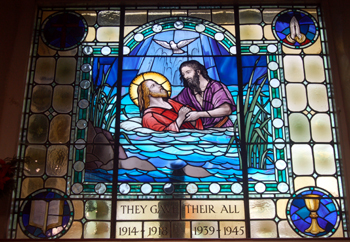
Stained glass war memorial window in West End Baptist Meeting December 2009
A new organ was installed in 1901, the Duke of Bedford contributing £10 towards the cost. This was replaced by a pipe organ in 1920. In 1944 a hut adjoining the church was acquired, £50 of the cost coming from American servicemen. In 1948 T. C. Skevington-Lodge, labour M. P. for Bedford unveiled a stained glass window in the church in memory of the dead of two World Wars.
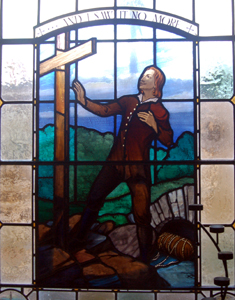
Tercentenary window in West End Baptist Meeting December 2009
Stevington celebrated its tercentenary in 1955 and Bedfordshire and Luton Archives and Records Service has the programme of celebrations. The programme includes a historical note by H. G. Tibbutt and the pastor, Ronald Rust, wrote: "A very sincere welcome is extended to all past members to visit our Church again at some time within this year. Then we desire to give the same welcome to friends of our Church, who through the years have taken an active and generous interest in our work. Many we hope will visit this place for the first time, and we trust that their visit will bring to them great blessing. This programme will probably reach the hands of a large number of friends in the United States of America, who during the war years frequently worshipped in our Church and shared the fellowship of many homes in the village here. To these friends across the sea we send our greetings".
The programme also takes the opportunity to ask for donations towards a target of £500, noting: "During December of last year extensive renewals and repairs were made with a considerable expense…Further there are many other repairs to the Church fabric which must be attended to in the immediate future, and thus we are confronted with heavy financial commitments. We feel that the possession of such an historic building lays a real responsibility upon us; and we are anxious in this Tercentenary year to preserve our Church, and to make it worthy of our heritage".
In 1962 a new hall was built at the west end of the church. In 1974 the rules of the church were changed to allow open membership. Thus one may now worship at the meeting without being baptised as an adult into the church.
By 2005 there was no longer a Sunday School at the meeting. Considerable repairs were made to the building in 2004 and 2005. At the time of writing the meeting has around 20 members some villagers and others from outside the village.
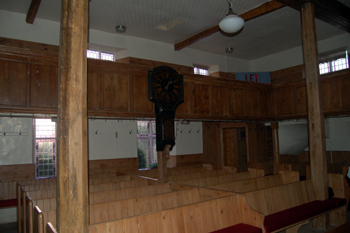 Interior of West End Baptist Meeting December 2009
Interior of West End Baptist Meeting December 2009